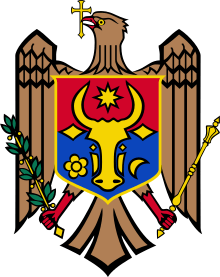Culture of Moldova
| Part of a series on the |
| Culture of Moldova |
|---|
 |
| History |
| People |
| Festivals |
| Religion |
|
Art
|
| Literature |
|
Music and performing arts |
| Sport |
|
Monuments |
|

The culture of Moldova is a combination of Romanian culture and Soviet culture. The traditional Latin origins of Romanian culture reach back to the 2nd century, the period of Roman colonization in Dacia.
During the centuries following the Roman withdrawal in 271, the population of the region was influenced by contact with the Byzantine Empire, neighboring Slavic, Magyar, and other smaller populations, and later by the Ottoman Turks. Beginning in the 19th century, a strong Western European (particularly French) influence came to be evident in Romanian literature, and the arts. The resulting mélange has produced a rich cultural tradition. Although foreign contacts were an inevitable consequence of the region's geography, their influence only served to enhance a vital and resilient popular culture.
The population of what once was the Principality of Moldavia (1359–1859) had come to identify itself widely as "Moldovan" by the 14th century, but continued to maintain close cultural links with other Romanian groups. After 1812, the eastern Moldavians, those inhabiting Bessarabia and Transnistria, were also influenced by the Slavic culture during the periods of 1812–1917, and 1940–1989, they were influenced by Russia, respectively by Soviet administrative control, as well as by ethnic Russian or Russian-speaking immigration.
By 1918, Bessarabia was one of the least developed, and least educated European regions of the Russian Empire. In 1930, its literacy rate was only 40%, according to a Romanian census, itself a huge increase from 12% some 30 years earlier under the Russian Empire. Especially low was the literacy rate for women, less than 10% in 1918, to just under 50% in 1940. Although, Soviet authorities promoted education (not the least to spread communist ideology), they also did everything they could to break the region's cultural ties with Romania. With many ethnic Romanian intellectuals, either fleeing, being killed after 1940, or being deported both during and after World War II, Bessarabia's cultural and educational situation worsened. The country became more Russified.
After the 1960s, Soviet authorities developed urban cultural and scientific centers and institutions that were subsequently filled with Russians, and with other non-Romanian ethnic groups, but this culture was superimposed and alien. Much of the urban culture came from Moscow; the rural ethnic Romanian population was allowed to express itself only in folklore or folk art.
Folk culture
Although the folk arts flourished, similarities with were hidden. Music and dance, particularly encouraged by Soviet authorities, were made into a showcase, but were subtly distorted to hide their Romanian origins. For example, the national folk costume, in which the traditional Romanian moccasin (opinca) was replaced by the Russian boot.
Moldova's traditional folk culture is very rich. The ancient folk ballads, such as "Mioriţa" and "Meşterul Manole", play a central role in this traditional culture. Folk traditions, including ceramics and weaving, continue to be practiced in rural areas. The folk culture tradition is promoted at the national level and is represented by, among other groups, the republic's dance company, Vantulet, and by the folk choir, Doina.
Literary culture
The first Moldovan books, religious texts, appeared in the mid-17th century. Prominent figures in Moldova's cultural development include mitropolitans Varlaam and Dosoftei, Grigore Ureche, Miron Costin, mitropolitan of Kiev Petru Movilă, scholars Nicolae Milescu-Spãtaru, Dimitrie Cantemir (1673–1723), and Ion Neculce, Gavriil Bănulescu-Bodoni, Alexandru Hîjdău, Alexandru Donici, Constantin Stamati, Costache Negruzzi, historian and philologist Bogdan P. Hasdeu (1836–1907), author Ion Creangă (1837–1889), and poet Mihai Eminescu (1850–1889).
Varlaam published the first books. Dosoftei founded numerous schools and published a lot. Cantemir wrote the first thorough geographical, ethnographical, and economic description of the country in Descriptio Moldaviae (Berlin, c. 1714).
Modern writers include Vladimir Beşleagă, Pavel Boţu, Aureliu Busuioc, Nicolae Dabija, Ion Druţă, Victor Teleucă, and Grigore Vieru. In 1991, a total of 520 books were published in Moldova, of which 402 were in Romanian, 108 in Russian, eight in Gagauz, and two in Bulgarian.
In the early 1990s, Moldova had twelve professional theaters. All performed in Romanian, except the A.P. Chekhov Russian Drama Theater in Chişinău, and the Russian Drama and Comedy Theater in Tiraspol, both of which performed solely in Russian, and the Licurici Republic Puppet Theater, in Chişinău, which performed in both Romanian and Russian. Although, among those controlled tendencies by Soviets, real artists in music formed real art-bands, such as "Ciocîrlia", led by Serghei Lunchevici and "Lăutarii" of Nicolae Botgros. Members of ethnic minorities manage a number of folklore groups and amateur theaters throughout the country.
Cuisine
Moldovan cuisine consists mainly of traditional European foods, such as beef, pork, potatoes, cabbage, cheese, and a variety of cereal grains. Popular alcoholic beverages are divin (Moldovan brandy), beer, and local wine.
Very popular dishes include manti (a type of dumpling filled with meat and vegetables, which is wrapped in a dough wrapper, and served with a spicy sour cream), ciorbă (a sour soup consisting of meat and vegetables, served with sauerkraut, polenta, or rice), pelmeni (another type of dumpling, filled with meat and onions, but sometimes mushrooms, turnips, and sauerkraut are added), borscht (made with beets, tomatoes, and other vegetables to form a stew), and sarma (a dish made with stuffed cabbage rolls, accompanied by sauerkraut and mămăligă).
Other common foods in Moldova include grilled meats, other grains, dairy products, and mămăligă (a type of polenta made with cornmeal, and mashed into a porridge).
Sports
See also
External links
| Wikimedia Commons has media related to Culture of Moldova. |
- Information about Moldova from the page of the Moldovan Ministry of Culture and Tourism (English)
- www.moldova.md about Modovan culture (English)
- www.tur.md about Modovan rest (English)
